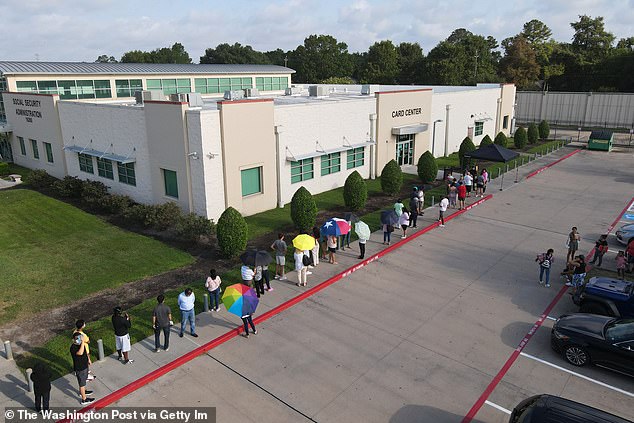What does a government shutdown mean for YOU? All your questions about who gets paid and which services will shut – with just FIVE DAYS for Congress to strike a deal
The federal government is heading for a government shutdown, with just a week left before the deadline for funding operations and no deal in sight between the Republican-led House of Representatives and the Democratic-led Senate.
If Congress misses the September 30 deadline for fiscal year 2024 funding without an agreement that can pass the House of Representatives and the Senate and receive the President’s signature, many government operations will be shut down and most employees are left without a salary.
Who still has to work – and who gets paid?
Even though the decision is in their hands, members of Congress will still get paid during a shutdown, as will federal judges and the president. However, their staff does not.
During a shutdown, many government operations come to a halt, but some are considered “essential” and continue with or without funding.
rashes can flood if people outside the Martin Luther King Jr. Memorial at the Tidal Basin, December 27, 2018, in Washington, during a partial government shutdown
Agencies deemed essential in previous shutdowns include federal law enforcement, active-duty military, border patrol and air traffic control.
Medicare and Social Security will continue to pay benefits.
However, services may be disrupted as around 15 percent of staff would be furloughed.
Other federal employees whose work is deemed “non-essential” are being furloughed, meaning they stop working and don’t get paid. Those deemed essential continue to work and are also not paid. They will be paid their lost wages once Congress reaches a funding deal to reopen the government.
During the 2018-2019 shutdown, the White House laid off 1,100 of the 1,800 staff members in the executive office of the president.
Which programs continue to function and which are closed?
Many lawmakers have said special prosecutors’ investigations, like those involving Donald Trump and Hunter Biden, would continue to operate. But Chairman Kevin McCarthy has warned conservative hardliners that the impeachment inquiry into President Biden would grind to a halt if a shutdown were to occur.
The White House issued a dire warning last week about the consequences of a shutdown.

People wait in line at a Social Security office before it opens on July 13, 2022 in Houston, Texas
It claimed that 10,000 children would lose access to Head Start programs across the country because the Department of Health and Human Services is not awarding grants during a shutdown.
And while essential workers are still being asked to work without pay, agencies have historically experienced high numbers of employees calling in sick. The White House also warned of the possibility of long airport delays in the event of a shutdown.
During previous shutdowns, some national parks have remained open.
During the 2019 closure, many parks remained open but were severely understaffed and operating without visitor services such as toilets and waste collection.
All Smithsonian museums, including the National Zoo, would close during a shutdown.
U.S. embassies and consulates would remain open, as would visa and passport processing.
There would be cuts to non-essential travel and speeches, and some foreign aid programs could run out of money. And during the last shutdown, tens of thousands of immigration hearings were canceled.
The Centers for Disease Control (CDC) would continue to monitor outbreaks, but about half of the agency’s employees would be furloughed. New clinical trials would be halted at the National Institutes of Health (NIH).
Most Federal Emergency Management Agency (FEMA) employees would remain on the job even if they no longer had money to help with disaster relief.

In this Jan. 3, 2019, file photo, a woman walks past trash piled next to a trash can at Ocean Beach in San Francisco
When was the last shutdown and how long did it last?
The last shutdown lasted 34 days from December 2018 to January 2019 – the longest in history.
At that point, congressional funding for nine departments with approximately 800,000 employees ran out. According to a report from the Congressional Budget Office (CBO), the five-week partial shutdown cost the economy approximately $11 billion. Anything but about $3 billion of that was recovered after the shutdown ended.
It also forced TSA agents out of work as they tried to find other ways to make money.
Previously, the record was 21 days during a 1995-1996 shutdown, when President Bill Clinton refused to accept Chairman Newt Gingrich’s sharp spending cuts and tax cuts.
In 2013, there was another 16-day shutdown as Republicans tried to gut the Affordable Care Act.
How many shutdowns has the US experienced?
According to the Congressional Research Service, there have been 20 gaps in funding since 1976 that lasted at least a day.
Before this, the government normally functioned even if the spending laws were not passed. Two opinions from Attorney General Benjamin Civiletti in 1980 stated that it was illegal for the government to spend money without congressional approval.
What will be the effect on air traffic?
The White House has warned that there could be “significant” delays.
A spokesperson said: ‘Air traffic controllers and TSA officers would be required to work without pay – potentially leading to significant delays and longer wait times for travelers at airports across the country, similar to previous closures.’
